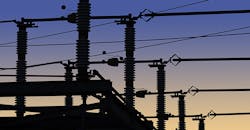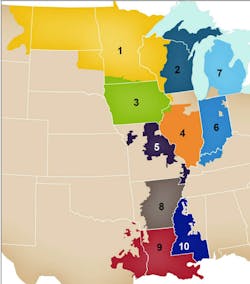Costs Rising, Supplies Falling. Except for One Option
The electric grid operator for the Upper Midwest is suddenly running short of supply for the commodity it manages, and this may put many foundries in very precarious position, too. If you operate in Zones 1 through 7 of the map below, you might soon be seeing much higher electric bills. You should contact your local electric utility now.
Here’s why. Midcontinent Independent System Operator (MISO) manages the electric grid in much of the Midwest. It ensures the integrity of the grid and plans for electric supply requirements. If your local electric utility does not have enough electricity supply to meet customer needs, it will buy additional capacity (electric supply) from MISO.Each year, MISO conducts an auction to arrange for its anticipated electric generation needs, and to determine the price that will be paid for the electricity it will supply in this way.
On April 15 2022, MISO announced its 2022/2023 Planning Resource Auction results, indicating that capacity prices are rising from $5/MW-day in 2021 to $236.66/MW-day this year. This dramatic increase apparently is driven by an uptick in projected electricity usage and a drop in power supply. The dip in the power supply seems to be traced to a shift from coal-fired generation assets to wind and solar renewable energy projects.
MISO is estimating a 5 gigawatt (GW) shortfall in “firm” generation resources this summer to meet the projected load. They are forecasting a summer peak of 124 GW, with about 119 GW of “projected regularly available generation.” The need for controlled power shutoffs will depend on the availability of “non-firm” resources like power imports from other grid operators and adequate wind generation within MISO. Indeed, the predicted shortfall is enough to plan for the possibility of rolling blackouts being used to protect the integrity of the grid.
According to Zak Joundi, MISO executive director, “We need to see more capacity being built, … but from a reliability standpoint, the system will not be compromised. We should expect that as we enter this [capacity] year with less capacity in the north-central region that we are likely to see more usage of the emergency procedures. MISO’s northern and central regions are at heightened risk for controlled ‘load sheds,’ or planned blackouts.”
Fifty-two coal-fired plants are used to generate more than 35% of the electricity used within MISO. But even that normally solid, baseload generation may be problematic. In September 2021, the Energy Information Agency (EIA), estimated utility coal stockpiles were at the level lowest since March 1978. EIA estimated that it will take most of 2022, or longer, before mines and railroads are able to restore inventories to a level comfortable to utilities.
Only the electric utility that delivers your electricity can say what effect all this have on your bill, so make that call for complete details. A lot depends on how much generation capacity is owned by, and available from, your local utility. If you are on an electric-supply contract, specific contract terms may help minimize the extent of higher costs.
Aside from reducing your electric consumption and/or going to off-peak operations, the actions you can take are limited. The electric utility has a monopoly to deliver electricity in the territory it serves. Or does it?
Turns out you have some options
If you are facing the prospect of large increases in your electric bill and have no other apparent options, consider a new approach: Generate your own electricity right on your property. Some foundries see many benefits after installing electric generators to generate some, or all, of their electricity needs. They won’t need to worry about grid blackouts and their cost of electricity is a lot less than what they currently pay for electricity. They can operate a furnace on any shift, not tied to utility rate plans for cheaper off-peak melting, etc.
Generation equipment vendors offer full-service maintenance and support; they handle the details so you don’t have to. You can have a real alternative to your electric company.
Option 1: Leasing. Generating equipment can be leased under a Power-as-a-Service agreement. This requires no capital from you; the vendor pays for the equipment and installation costs. You pay the vendor a fixed rate for electricity you consume from the equipment for a specified number of years. In effect, this is a form of lease of the equipment, renewable at the end of the lease.
Option 2: Capital investment. Generating equipment can be purchased just as for any other capital project. Aggressive ROI may make this an attractive option.
Your own generating capability allows you to benefit from the maximum savings available, including not having to pay for Capacity costs – which are a major component of your electric utility bill. Equipment vendors offer maintenance agreements to maintain the equipment, so you can focus on running the foundry.
Brian Reinke, president of TDI Consulting, is an energy-cost saving consultant. Contact him at [email protected] for a customized, no-obligation quote for your own on-site electric system.
About the Author
Brian Reinke
President
Brian Reinke, president of TDI Energy Solutions, is an energy-cost saving consultant. Contact him at 630-343-0971.

